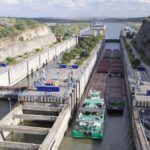In Târgoviște, a small town 80 kilometres northwest of Romania’s capital Bucharest, best known as the site of the princely court of 15th century ruler Vlad Țepeș (the inspiration for Bram Stoker’s Dracula), Maria Sandu’s workshop hums with activity.
She and her husband handcraft high-end leather bags for boutiques across Romania and more recently, much of Europe. Last year, they took on a third apprentice and hired a part‑timer to keep up with orders.
But when Sandu tried to navigate Romania’s tax code, she spent weeks filling out forms and chasing signatures. Meanwhile, dozens of press releases celebrated the announcement earlier this year of a new arms factory near Târgoviște set to create 2,000 jobs.
It’s hard to feel like the backbone of the economy when you’re left picking up the paperwork.
Small and medium‑sized enterprises (SMEs) make up 99 per cent of businesses in the EU and employ two‑thirds of its workforce. In Central and Eastern Europe, that figure inches even higher. Yet investment agencies persistently roll out the red carpet for multinational giants.
Mega‑projects garner subsidies, broken‑ground ceremonies and high‑profile photo‑ops. Family‑run bakeries, machine‑shops and digital start-ups slip through the cracks.
Creaking bureaucracy
Take employment rules. In Slovakia, Jan Novak runs a café in Košice. He needs the freedom to hire a barista for the summer rush and let them go when the season ends. But local labour laws treat a fixed‑term contract as tantamount to a lifetime promise.
The cost of firing—even when business dwindles—can be ruinously high. Novak must choose between stagnation and risk. Either way, his little café cannot grow.
Meanwhile, in Bucharest, hope arrived on a flight from Delhi. Amrit Singh arrived in Romania last spring with a degree in engineering but no fluent Romanian. Bucharest’s booming tech scene beckoned, and a small software firm offered him a job.
Yet the immigration process creaked. Months passed before his papers were stamped. His employer, starved for talent, saw projects delayed and clients annoyed. If firms could onboard skilled foreigners more swiftly, they would not hold back on expansion.
In parts of Poland, however, a different story unfolds. Białystok, once known for its textile mills, now bristles with coding hubs. Young coders trade memes over coffee as they build apps for clients in Berlin and London.
The city, long bypassed by big‑name investors, became a testing ground for targeted regional grants and mentorship schemes.
Local authorities tore up red tape and offered workspace in old factories. Start-ups sprouted like mushrooms after rain. The result? A new Silicon Forest that did not rely on foreign corporate giants but on local ingenuity.
Limping along
Access to finance remains thorny, though. In northern Slovakia, Robert Kovač runs a small tool‑making shop. He has orders lined up until next spring. Yet every bank manager he meets demands collateral worth twice the size of his loan request. He could sell off family land or risk his home.
Instead, he limps along on credit cards, paying sky‑high interest. Without public loan guarantees or SME‑focused funds, countless entrepreneurs find themselves frozen out.
Corruption and red tape still shadow even the brightest prospects. In parts of Ukraine, Bulgaria and Romania, unclear regulations and occasional graft can turn a routine permit into a gamble. Business owners hire middlemen, pay inflated fees or simply abandon projects.
The message is clear: if you’re small, you are expendable. If you’re big, you may wield enough influence to push past such obstacles.
Yet hope glimmers in the Baltic states. Estonia’s tax system, famously simple, allows companies to reinvest profits without immediate taxation. Small enterprises reinvest every euro back into expansion, equipment or staff training.
The result has been a surge of start-ups and agile family firms that rarely hit a bureaucratic wall. That model could inspire CEE neighbours to overhaul complex codes and embrace clarity over confusion.
Creating communities
CEE governments are starting to listen. In Hungary, a pilot scheme allows entrepreneurs to choose simplified, flat‑rate taxation.
In Poland, labour inspectors now offer advisory visits instead of surprise audits. Even Romania has fast‑tracked visa approvals for high‑skilled workers in priority sectors. These changes are small steps, but they signal a shift: homegrown businesses finally edging toward the centre of the economic stage.
Behind every policy shift are human stories. In Bulgaria, the Petrov family vineyard once struggled to hire pickers and cellar hands. Now, seasonal workers from Vietnam and Nepal arrive on short‑term contracts. They bring skills, stories and remittances home. In return, the Petrov brothers rehire local teens for packaging and tasting‑room duties. The vineyard has become a community.
It is time CEE governments see SMEs not as afterthoughts but as vital organs. Tax codes must reward reinvestment, not penalise it. Employment laws should respect the ups and downs of small businesses. Immigration rules must welcome skills where local talent is scarce. And finance must move from being a fortress door to a friendly handshake.
Building economies that last
There are no silver bullets. Each country and region requires its own recipe, tailored to local strengths and weaknesses. But one truth holds: economies built on a few corporate giants remain vulnerable. When big firms leave, they take promises, power and payrolls with them. Foreign direct investment in Romania, for example, fell by more than seven per cent in the 12 months to November 2024.
SMEs, however, are rooted. They adapt. They reinvent. They endure.
In workshops, offices and family kitchens across Central and Eastern Europe, entrepreneurs keep faith in tomorrow. They tinker, code, bake and weld not for headlines, but for their communities. They are the unsung heroes who employ neighbours, breathe life into small towns and invent solutions to local problems.
If CEE wants a resilient future, it must bet on these everyday pioneers. Because when small businesses thrive, entire regions prosper—and the next Maria, Jan or Amrit will find the door open, the paperwork minimal and the tax man a friend, not a foe.
That is how you build economies that last.
Photo: Dreamstime.







